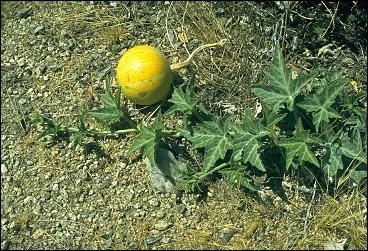
Winter comes even to the Chihuahuan Desert, and the muted greens of summer give way to the olive drab and gray of sleeping plants. Yet, some remnants of warmth linger. Within the withered skeleton of a long-dead vine, you may see a lemon-yellow sphere hoarding the captured sunlight of summer in the form of seeds ready to be released with the heat of late spring.
The coyote gourd, or calabacilla loca, is a member of the cucumber family and, like other gourds, secretes its seeds within a rind. As the gourds ripen, the watermelon-like seeds often show up in coyote droppings. Not only are the seeds scattered, they're fertilized as well. Uneaten gourds eventually dry and become light enough to be blown away by winter winds. Over time, the rind weathers away, and the seeds inside are released.
Native Americans ground seeds for a food rich in oils and protein and
used the dried gourds as ceremonial rattles. The burnable roots contain large amounts
of starch and may weigh well over 200 pounds in older plants. Close relative or not,
this is no cucumber!
![]()
Contributor: Arthur H. Harris, Laboratory for Environmental Biology, Centennial Museum, University of Texas at El Paso.
Desert Diary is a joint production of the Centennial Museum and KTEP National Public Radio at the University of Texas at El Paso.

Coyote Gourd (Cucurbita palmata), a species closely related to the Chihuahuan Desert form (Cucurbita digitata). Joshua Tree National Monument, 4 April 1984, Riverside Co., CA. © Br. Alfred Brousseau, Saint Mary's College.
Dimmitt, M. A. 2000. Cucurbitaceae (cucumber family). Pp. 222-223, in A natural history of the Sonoran Desert (S. J. Phillips and P. W. Comus, eds.). Arizona-Sonora Desert Museum Press, Tucson. 628 pp.
Heiser, C. B. 1979. The Gourd Book. University of Oklahoma Press, Norman.
Wayne's Word on Gourds.